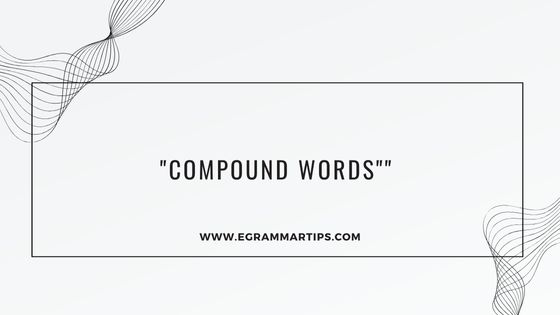
Compound words play an essential role in English grammar. They enhance language efficiency by combining two or more words to form a single word with a distinct meaning. This lesson will cover everything you need to know about compound words, including their types, formation rules, and usage.
Table of Contents
ToggleWhat Are Compound Words?
Compound words are formed when two or more individual words come together to create a new word with a unique meaning. These new words often describe concepts or objects that don’t have a single word counterpart.
Types of Compound Words
There are three main types of compound words, which differ in the way they are written:
1. Closed Compound Words
2. Hyphenated Compound Words
3. Open Compound Words
1. Closed Compound Words
Closed compound words are formed by joining two words together without spaces or hyphens. They are written as a single word. Over time, certain word pairs that originally were written as separate words have become closed compounds due to frequent usage.
Examples:
- Notebook – A book for taking notes.
- Football – A sport played with a ball.
- Sunflower – A tall plant with a large, bright yellow flower.
Usage Tips:
Closed compounds are often nouns, but they can also be verbs (e.g., “overcome”) or adjectives (e.g., “sunbaked”).
Words tend to become closed compounds as they are used more frequently, such as “anybody” from “any body.”
2. Hyphenated Compound Words
Hyphenated compound words use a hyphen (-) between two or more words. The hyphen connects the words together to show that they function as a single concept. Hyphenated compounds are often used for compound adjectives, especially before a noun, or to avoid confusion.
Examples:
- Mother-in-law – The mother of one’s spouse.
- Well-known – Famous or widely recognized.
- Editor-in-chief – The head editor of a publication.
Usage Tips:
Hyphens are used to clarify meaning.
For example, “small-business owner” is different from “small business owner” (the former specifies a business owner who runs a small business, while the latter can suggest a person who is small).
Use hyphens to link words that form compound modifiers before a noun (e.g., “state-of-the-art technology”).
Always use a hyphen in numbers between twenty-one and ninety-nine (e.g., thirty-two).
3. Open Compound Words
Open compound words consist of two or more words that are written with a space between them but are considered as one entity in meaning. While each word is separated, together they convey a single idea.
Examples:
- Post office – A place where mail is sent and received.
- Ice cream – A frozen dairy dessert.
- Full moon – The lunar phase when the moon is fully illuminated.
Usage Tips:
Open compounds are often found in phrases that describe things (like “ice cream”) or proper nouns (like “New York”).
Many compounds start as open and become hyphenated or closed as they become more common over time, such as “online shopping” evolving from “on line shopping.”
How Are Compound Words Formed?
Compound words are formed by combining different parts of speech. These combinations include:
- Noun + Noun: toothbrush, schoolhouse
- Adjective + Noun: blackboard, blueberry
- Verb + Noun: breakfast, safeguard
- Verb + Preposition: check-in, takeover
- Preposition + Noun: underpass, overload
Rules for Using Compound Words
Understanding when to use closed, hyphenated, or open compound words can be tricky. Here are some general rules to follow:
1. Compound Adjectives Before Nouns
When two words work together as an adjective before a noun, they are often hyphenated to clarify meaning.
Example:
Well-written essay (adjective)The phrase describes an essay that is written well.
Exception: If the compound adjective comes after the noun, the hyphen is usually dropped.
Example:The essay is well written.
2. Use Hyphenated Compounds to Avoid Ambiguity
Hyphens help avoid confusion in certain contexts. For example:
Example:
Man-eating shark (a shark that eats humans)
Man eating shark (a man is eating a shark)
The hyphen changes the meaning dramatically!
3. Verbs and Prepositions
Some compounds that are formed with verbs and prepositions tend to be closed or hyphenated when used as nouns.
Examples:
Breakthrough (noun) – A sudden discovery or development.
Break-through (verb) – To force your way through something.
4. Compound Nouns
Most compound nouns are closed or open compounds. The choice between them can often depend on how long the word pair has been in use and how the meaning has evolved.
Examples:
Mailman – A person who delivers mail (closed).
Ice cream – A sweet frozen treat (open)
Common Mistakes with Compound Words
1. Confusing Hyphenated and Closed Compounds
Many learners struggle to know when to hyphenate words and when to write them as one.
For instance, “high school” is an open compound, while “mother-in-law” is hyphenated.
2. Using a Hyphen Incorrectly
A common mistake is adding unnecessary hyphens to closed compounds.
For example, “tooth-brush” is incorrect, as it should be written as “toothbrush.”
How to Identify Compound Words
1. Context: Understanding the relationship between the words will help. Ask if the two words function as a unit to express a specific idea.
2. Meaning: If the meaning of the combined words is different from the sum of its parts, it’s likely a compound word (e.g., “notebook” is a book for notes, not just any “note” and “book”).
3. Dictionary: When in doubt, check a dictionary. Many dictionaries specify whether a compound word should be open, closed, or hyphenated.
Examples of Compound Words by Type
Closed Compound Words:
1. Airport
2. Basketball
3. Toothpaste
4. Notebook
5. Cupcake
Hyphenated Compound Words:
1. Brother-in-law
2. Check-in
3. Well-being
4. Self-esteem
5. Editor-in-chief
Open Compound Words:
1. High school
2. Living room
3. Ice cream
4. Full moon
5. Real estate